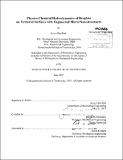Physico-chemical hydrodynamics of droplets on textured surfaces with engineered micro/nanostructures
Author(s)
Park, Kyoo Chul
DownloadFull printable version (23.68Mb)
Other Contributors
Massachusetts Institute of Technology. Department of Mechanical Engineering.
Advisor
Gareth H. McKinley.
Terms of use
Metadata
Show full item recordAbstract
Understanding physico-chemical hydrodynamics of droplets on textured surfaces is of fundamental and practical significance for designing a diverse range of engineered surfaces such as low-reflective, self-cleaning or anti-fogging glass, easy-cleaning robust inkjet printer heads, or efficient fog-harvesting surfaces. Developing such functional surfaces requires interdisciplinary considerations that have not been broadly explored and which integrate principles from capillarity, optics, nanofabrication, hydrodynamics of complex fluids, and even aerodynamics. The primary contribution of this thesis is to integrate consideration of wetting phenomena coupled with reflection of light, mechanical failure of slender structures, energy dissipation in non-Newtonian fluids, and aerodynamics of airborne droplets impacting onto permeable structures. Based on this integrative understanding, we construct design frameworks for both quantifying the performance of the desired functionalities for each application and for developing optimal functional surfaces. The first part of this thesis is focused on the development of superhydrophobic and superphotophilic surfaces that can be used for improving light-harvesting efficiency of photovoltaic cells. A design framework that combines wetting phenomena and adiabatic refractive index-matching together with a novel nanofabrication method is introduced to select slender tapered nanostructures that fulfill the multiple functionalities. The resulting nanoconetextured glass substrate exhibits highly robust superhydrophobicity and omnidirectional broadband anti-reflectivity as well as self-cleaning or anti-fogging property when conformally coated with a suitable chemical layer. Extending the nonwettability of textured surfaces to low surface tension oils is more difficult because oleophobic surfaces require a re-entrant topography. Deep reactive ion etching is used to fabricate square arrays of silicon nanopillars with wavy sidewalls that help support the superoleophobic state. The effect of the re-entrant nanotexture on the apparent contact angle, contact angle hysteresis, and sliding angle of water and hexadecane droplets is studied. We discuss numerical predictions for the critical pressure differences that cause failure of the Cassie- Baxter state that characterizes the super-repellent state for water and hexadecane droplets on the textured surfaces. In addition, dimensionless design parameters for quantifying the resistance to bending or buckling of the slender nanostructures are derived to design robust superoleophobic inkjet printer heads. Because of the natural repellency of many leaf surfaces to water, non-Newtonian fluids such as dilute polymer solutions are widely used to maximize the deposition rate of aqueous droplets sprayed onto textured liquid-repellent target surfaces. The drop impact dynamics of complex liquids on such surfaces is studied to develop a systematic understanding of the coupled effects of fluid viscoelasticity and the resulting dynamic wetting characteristics. We use hydrophobically-coated flat glass substrates, microtextured pillar surfaces, and nanocone surfaces as well as natural lotus leaves in conjunction with impacting droplets of dilute polyethylene oxide solutions to construct a drop impact dynamics diagram that can be used for understanding deposition of complex fluids on a wide range of hydrophobic textured surfaces. Lastly, the fundamental principles underlying the collection of fog droplets impacting permeable and textured structures such as woven meshes are studied. A design map predicting the theoretical collection efficiency is constructed based on two important dimensionless ratios that characterize the mesh geometry and the impacting droplet stream. Two physical limitations associated with clogging and re-entrainment are identified and potential solutions utilizing surface wettability are discussed. We use a family of physico-chemically patterned meshes with a directed stream of fog droplets to simulate a natural foggy environment and demonstrate a fivefold enhancement in the fog-collecting efficiency of a conventional polyolefin mesh. The design rules developed in this thesis can be applied to select a mesh surface with optimal topography and wetting characteristics to harvest enhanced water fluxes over a wide range of natural convected fog environments. In summary, by developing an integrative understanding of the physico-chemical hydrodynamics of droplets on textured substrates, we have been able to realize a number of novel functionalities using textured surfaces and have constructed design frameworks that can be applied for optimizing the performance of each multi-functional surface. For future work, initial steps for commercializing several of these multi-functional surfaces developed in this thesis are briefly discussed.
Description
Thesis (Ph. D.)--Massachusetts Institute of Technology, Dept. of Mechanical Engineering, 2013. Cataloged from PDF version of thesis. Includes bibliographical references.
Date issued
2013Department
Massachusetts Institute of Technology. Department of Mechanical EngineeringPublisher
Massachusetts Institute of Technology
Keywords
Mechanical Engineering.